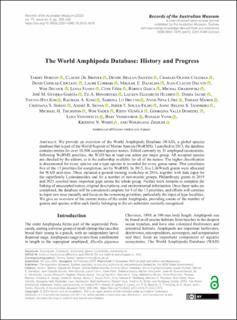The World Amphipoda Database: History and Progress
Horton, Tammy; De Broyer, Claude; Bellan-santini, Denise; Coleman, Charles Oliver; Copilas-Coicianu, Denis; Corbari, Laure; Daneliya, Mikhail E.; Dauvin, Jean-Claude; Decock, Wim; Fanini, Lucia; Fiser, Cene; Gasca, Rebeca; Grabowski, Michał; Guerra-Garcia, Jose M.; Hendrycks, Ed; Hughes, Lauren E.; Jaume, Damià; Kim, Young-Hyo; King, Rachael; Brutto, Sabrina Lo; Lörz, Anne-Nina; Mamos, Tomasz; Serejo, Cristiana S.; Senna, Andre; Souza-Filho, Jesser F.; Tandberg, Anne Helene Solberg; Thurston, Michael H; Vader, Wim; Väinölä, Risto; Domedel, Georgiana Valls; Vandepitte, Leen; Vanhoorne, Bart; Vonk, Ronald; WHite, Kristine N; Zeidler, Wolfgang
Journal article, Peer reviewed
Published version
Permanent lenke
https://hdl.handle.net/11250/3117979Utgivelsesdato
2023Metadata
Vis full innførselSamlinger
- Department of Natural History [297]
- Registrations from Cristin [9791]
Sammendrag
We provide an overview of the World Amphipoda Database (WAD), a global speciesdatabase that is part of the World Register of Marine Species (WoRMS). Launched in 2013, the databasecontains entries for over 10,500 accepted species names. Edited currently by 31 amphipod taxonomists,following WoRMS priorities, the WAD has at least one editor per major group. All accepted speciesare checked by the editors, as is the authorship available for all of the names. The higher classificationis documented for every species and a type species is recorded for every genus name. This constitutesfive of the 13 priorities for completion, set by WoRMS. In 2015, five LifeWatch grants were allocatedfor WAD activities. These included a general training workshop in 2016, together with data input forthe superfamily Lysianassoidea and for a number of non-marine groups. Philanthropy grants in 2019and 2021 covered more important gaps across the whole group. Further work remains to complete thelinking of unaccepted names, original descriptions, and environmental information. Once these tasks arecompleted, the database will be considered complete for 8 of the 13 priorities, and efforts will continueto input new taxa annually and focus on the remaining priorities, particularly the input of type localities.We give an overview of the current status of the order Amphipoda, providing counts of the number ofgenera and species within each family belonging to the six suborders currently recognized.

